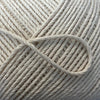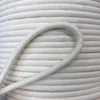Which piping cord to use for my project?
Antonia MarinoThe choice of piping cord plays an important role in the outcome of your sewing and upholstery projects. Piping not only adds a polished finish but also enhances the durability of your creations, creates shape and structure, and can give it a contrasting look.
FAQ: How do I sew my own piping cord?

Twisted Piping Cord:
Cotton twisted piping cord stands out as a versatile and economical option. Constructed by twisting strands of cotton together, it boasts a sturdy yet flexible nature. This type is particularly well-suited for straightforward projects like cushions, pillows, and basic upholstery. It is best suited for sturdy fabrics, so the twist shape doesn't show through the fabric.
Twisted piping cord can also be brought in multiple colours. These are usually used as a decorative trim, instead of being wrapped in fabric. Twisted cord can be glued or sewn into place.

Braided Piping Cord:
For those seeking a more refined and robust alternative, braided piping cord proves to be an excellent choice. This is the most common piping for upholstery projects, with 4mm piping being the most popular thickness. Fashioned by braiding cotton strands together, it offers a smoother and more polished appearance compared to its twisted counterpart.
This type of cord is often employed in intricate projects where a sophisticated finish is desired, including home decor and upholstery. Thicker cords can be use as an edge roll under the padding so project wooden edges.

Soft Filler Piping Cord:
The softer piping cord is designed specifically for projects requiring a gentle touch. Ideal for soft pipe fillings, especially on cushions and other home decor items.
This cord enhances comfort without compromising on durability. Its application is perfect for creating plush and inviting pieces that prioritise coziness. This piping is less common, but when it is used sizes 6mm and over are used. It can also be used as edge rolls.

Plastic Piping Cord:
Plastic piping cord emerges as the preferred option for projects requiring resilience against moisture and wear. This is the most common piping for outdoor cushions, patio furniture, marine and auto upholstery and any other items exposed to the elements.
The most common sizes are 3mm and 4mm. The easy-to-clean and shape-retaining qualities make plastic piping cord a practical choice for both indoor and outdoor DIY projects.

